 |
 |
 |
|
| |
| |
About this Project |
|
|
 |
| |
|
|
| |
| Mission |
The
underlying philosophy of our scheme is: Students learn
best by doing, not listening. The scheme involved a
group of talent students to carry out research with
our Physics faculty members. The project courses involved
include the one offered to final year students (PHYS
398: 4 credits) and those offered to all years of UG
physics students (PHYS 191/291/391: one credit).
Our scheme aims at:
|
|
To
develop a learning culture by involving students in
further development of the discoveries and inventions
recently developed in the department of Physics; |
|
To
encourage student-led experimental research to develop
students' independent and critical thinking, and various
technical skills; |
|
To
utilize research outcome from this scheme for enriching
undergraduate experimental physics courses and promoting
science to general public. |
|
|
| |
|
|
| |
|
|
| |
Supervisors |
|
| |
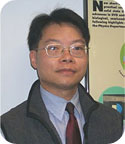 |
| |
 |
Project
Leader |
|
 |
| Prof.
Sou Iam Keong |
| Tel
: |
(825)
2358-7476 |
| Email :
|
phiksou@ust.hk |
|
|
|
|
| |
|
|
| |
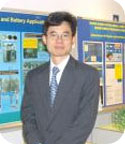 |
| |
 |
Memebers |
|
 |
| Prof. Chan
Che Ting |
| Tel
: |
(852) 2358-7487 |
| Email : |
phchan@ust.hk |
 |
|
|
| |
|
|
|
| |
 |
|
|
| |
|
|
|
| |
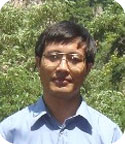 |
|
|
| |
|
|
|
| |
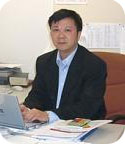 |
|
|
| |
|
|
|
| |
 |
|
|
| |
|
|
|
| |
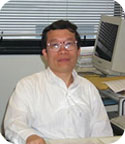 |
| |
 |
| Prof. Tam
Wing Yim |
| Tel
: |
(852) 2358-7490 |
| Email : |
phtam@ust.hk |
|
|
|
| |
|
|
| |
|
|
|
| |
Acheivements |
|
| |
 |
Undergraduate
Education
This novel approach has achieved
many objectives of an all-round university education
through equipping students with core skills and knowledge
in up-to-date science development, searching, discovering,
integrating and organizing knowledge, problem solving,
oral and written presentation, experimental design &
fabrication, team working and communicating their
ideas, which are transferable into post-university experience.
|
 |
Demo/teaching
Kits
Since the scheme started in Oct
2005, a wide range of topics has been offered to participated
students, including UV Science, lithography based on
laser holography, sonic band-gap structures, nano science
& technology, Leaky Bucket Simulation of Multi-Service
Mobile Network and ER Fluid, etc. This approach has
resulted in six software- and five hardware-demo/teaching
kits. So far, one teaching kit (sonic bandgap experiment)
has been developed into an experimental setup with an
integrated lab manual, which has been added as a new
topic in the course PHYS311 (Advanced Experimental Physics)
since the summer semester of 2007.
|
 |
Outreach
Activities
Some of the research outcome of
this scheme has been used in promoting science either
through offering mini-lecture series in a number of
local secondary schools, or through HKUST Outreach Day
(2006 and 2007) and in-campus lab visits by local/overseas
secondary school students. In particular, the achievement
from the projects based on the UV detection technology
has been selected by the Science School as a showcase
in the Innovation Expo 2007 held in Hong Kong Convention
and Exhibition Centre in the period of 14th - 18th Sept.
2007.
|
 |
Integration
The innovations of this approach
were successfully integrated into the students' learning
process of the project courses in the following ways.
|
Having
selected their research topics, students need to
learn in-depth about these scientific inventions
through searching and reading extensively lots of
related reviews, it encourages students' independent
learning and critical evaluation of their own methodologies
to be applied in their research work. |
|
To realize
the practical outcome in the form of multimedia
presentations, science games, demo & teaching
kits, students will learn skills of computer animations,
video editing, mechanical drawing, electronic circuit
design and lab manual design. |
|
To get
well prepared for participating the outreach activities,
students will review the video files that record
the presentations and demonstrations conducted by
students participating the mini-lecture series in
previous semesters. Their presentation skills were
also got sharpen through rehearsal sessions and
from the feedback and consultation offered by faculty
members and staff from CELT. |
|
Through
working in a small focused group, students developed
their team working skills and general communication.
Team work helps to enhance students' academic achievement
and promote peer support and friendship. |
|
The experience
of interacting with a large and broad audience in
the outreach activities improved the confidence
of the students. |
|
|
|
| |
|
|
| |
|
|
| |
Evaluation |
|
| |
 |
Presentation
Assessment Checklists
Presentation assessment checklists
were distributed to the audience for evaluating the
research work and the performance of the students during
their end-semester presentations. The checklists contain
20 multiple-choice and 1 open-ended questions in five
general aspects, which are the Content, Organization,
Delivery technique, Challenging situation and Language.
For each of all the aspects and their sub-aspects being
evaluated, 5 is the full mark of score.
Figure 1, shows the response summary on the five aspects
of the project presentations given by the participated
students. As shown in Fig 1, all the 5 aspects' responses
are positive. It shows that the audience was well satisfied
with the planning, management and handling of the projects,
as well as the performance of the student presenters.
As an example, Fig. 2 displays the detailed response
summary on the sub-aspects of the content of the project
presentations. As shown in Fig.2, responses were overwhelmingly
positive. Audience agrees that our projects are interesting,
able to introduce up-to-date scientific discovery and
the research ideas are supported with relevant scientific
knowledge.
|
 |
Demonstration
Assessment Checklists
During our outreach activities,
such as the HKUST Outreach Day and the science mini-lecture
series in secondary schools, the students have demonstrated
the demo/teaching kits developed from this scheme. Demonstration
assessment checklists were distributed to the secondary
school teachers and students at the end of the demonstration.The
checklists contain 6 multiple choice and 1 open ended
questions. Fig.3 is the summary of evaluation on the
demonstrations received from the secondary school students
and teachers. They agree that installation of such a
setup in their school could stimulate their learning.
They also agree that our demonstration arouses their
interest in scientific research.
|
| |
| |
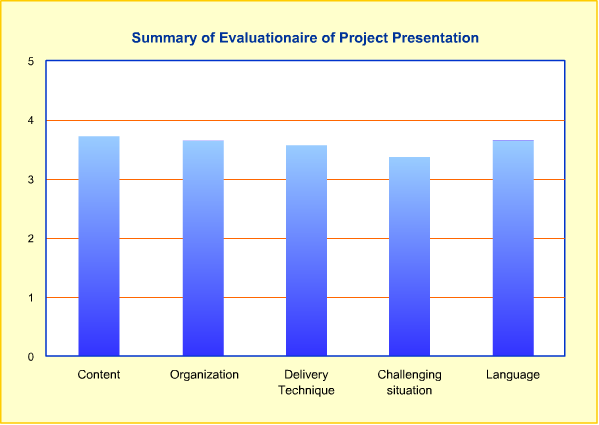 |
Figure
1: Statistics of the presentation assessment checklists
(sample size = 55) on five aspects of the project
presentations. |
| |
| |
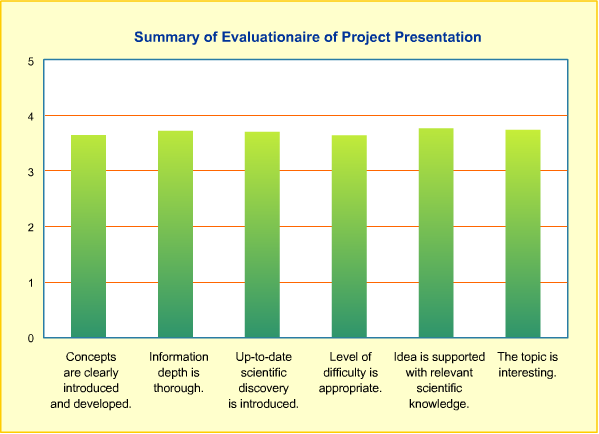 |
Figure
2: Statistics of the presentation assessment checklists
(sample size = 55) on six sub-aspects of the content
of the project presentations. |
| |
| |
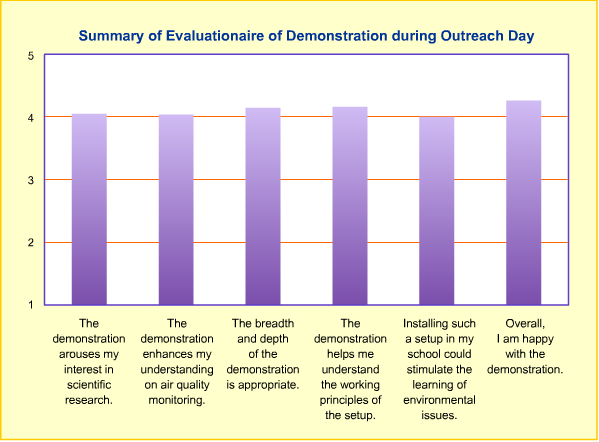 |
Figure
3: Statistics of the evaluation (sample size =
143 from 23 schools) on six aspects of the demonstrations
during outreach activities. |
|
|
|
| |
|
|
| |
|
|
|
| |
Peer
Support |
|
| |
|
The
Physics teaching lab has been providing kindly support
in terms of the working space and technical support
for some students involving the development of demo
& teaching kits. |
|
Staff
members from CELT attended the oral presentations by
the participated students at the end of each semester.
They also helped design the question sheets for outreach
activities and oral presentations for onsite evaluation
assessment and conduct group or individual interviews
after the presentations. |
|
Prof.
Alex Lau of Environmental Central Facility has viewed
the demonstration of the air pollution monitoring system
developed in this approach and offered his stimulating
suggestions and positive comments. |
|
School
of Science has arranged a number of lab visits from
overseas institutions to introduce some of our achievements
and selected the projects based on the UV detection
technology as a show case in the Innovation Expo 2007. |
|
|
| |
|
|
|
| |
|
|

